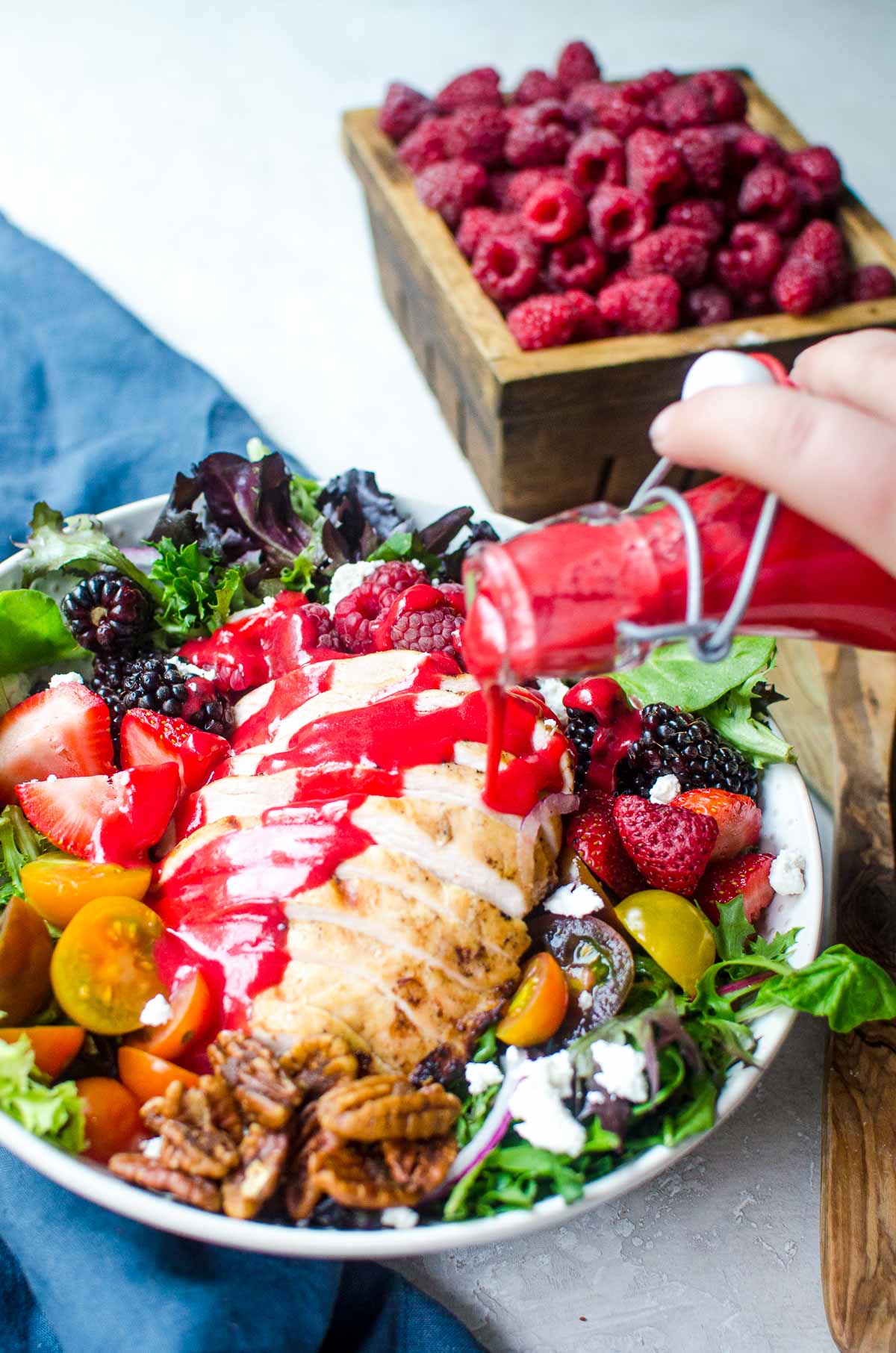This tangy raspberry vinaigrette blends together flavors for a dressing that isn't just fruity. Its savory components lend a flavor profile that gives a perfect sun-kissed summer flavor to any salad.

Why This Recipe Works
A lot of raspberry vinaigrette dressing recipes out there give you the most basic components: raspberries, vinegar, and oil. However, if you've ever read the back of your favorite salad dressing bottle then you know that that's not where it should stop.
This dressing already has sweet, tangy, and acidic flavors, so what else could it need?
By adding in just three extra ingredients you elevate the recipe to an expert level by creating a flavor profile worthy of a restaurant.
What's Goes Into the Recipe?

To make this raspberry vinaigrette dressing you need:
- Raspberries. For the best flavor, I recommend the freshest raspberries you can get. However, this recipe can absolutely be made with frozen: just be careful because thawed raspberries lose their structure so you'll get more than you need in the measuring cup.
- White Wine Vinegar. This bright vinegar compliments the fresh fruit well and gives the dressing that summertime vibe. If you want a little more flavor depth, substitute with red wine or balsamic vinegar.
- Olive Oil. The olive oil broadens the flavor profile but isn't a requirement. If you want the raspberries to stand out more, choose a neutral oil like avocado, canola, or vegetable.
- Shallot. One single shallot sweetens this dressing in a way the raspberries cannot. Don't have one nearby? Use ¼ of a yellow onion instead.
- Dijon Mustard. Dijon mustard is made with white wine in it, which accompanies this vinaigrette well. If you don't have dijon available, it's better to skip this ingredient than put in something that will taint the dressing.
Like I mentioned above, you can use substitutions for the raspberries, but fresh is absolutely the best. See my expert tips below for substitutions.
How To Make This Recipe


In a food processor, blend the raspberries, vinegar, shallot, and dijon mustard until smooth.

Pulse in the olive oil slowly until completely combined. (See tips below.)

Transfer the dressing into a fine-mesh sieve and use a spoon to push the liquid through, leaving the seeds behind.

Transfer to an airtight container and refrigerate for up to one week.

Expert Tips
- Olive oil becomes bitter when blended at high speeds, like with a food processor. Try to add the olive oil in gentle pulses rather than straight blending so that you can see exactly when it is combined and stop before the polyphenols release and make the vinaigrette bitter.
- Want to make the flavor of this vinaigrette even more unique? Substitute a tablespoon of the oil with a seed or nut oil instead. Try using walnut oil, pumpkin seed oil, or hazelnut oil. These oils shine in a cold dish like salad and take your vinaigrette to the next level.
- If you need to use frozen raspberries it is better to measure the berries while still frozen. However, if they're stuck together at all this may be hard to do. If measuring thawed, spoon the raspberries into the measuring cup being really careful not to squish and compact them.
- Another alternative to fresh berries is raspberry jam. This creates a much sweeter vinaigrette because most of the tangy bite that raspberries have is already overbalance with sugar for preserving. At the very end, thin out the dressing with water or fruit juice to get it to the right consistency.
Fun fact: This raspberry dressing recipe is unique because it doesn't require an emulsifier to keep the oil from separating. For more technical information on why check out this guide to making vinaigrettes.

FAQ's
The best raspberry vinaigrette is made of fresh raspberries, vinegar, and oil. However, it shouldn't stop there. By adding some additional ingredients like dijon mustard, shallot, or herbs you get a well-rounded flavor profile that makes the vinaigrette conform to the salad as an ingredient rather than a condiment.
Refrigerated in an airtight container, raspberry vinaigrette lasts 3-4 days before it begins to separate. If pulsed back together, you can refrigerate it again for another 1-2 days.
The best way to fix a thin vinaigrette is with fruit puree. Measuring berries by volume is tricky because they often stick out of the measuring cup, making it difficult to tell if you have too many or too few. Puree a few extra, strain out the seeds, and whisk the puree into the vinaigrette with a fork to thicken it.
Related Recipes
For more great salad and vinaigrette recipes, I recommend:


Red Raspberry Vinaigrette Dressing
Ingredients
- 1 ½ cups fresh raspberries
- ¼ cup white wine vinegar
- ½ cup olive oil
- 1 shallot, minced
- 1 teaspoon dijon
- salt and pepper, to taste
Instructions
- In a food processor, blend together the fresh raspberries, white wine vinegar, dijon mustard, and shallot. Pulse in the olive oil until just combined.
- Transfer the dressing to a fine mesh sieve over a bowl or jar. Use a spoon to push the vinaigrette through the holes, leaving behind the seeds. Transfer the vinaigrette to an airtight container, season with salt and pepper and refrigerate until ready to use.
Notes
- Olive oil becomes bitter when blended at high speeds, like with a food processor. Try to add the olive oil in gentle pulses rather than straight blending so that you can see exactly when it is combined and stop before the polyphenols release and make the vinaigrette bitter.
- Want to make the flavor of this vinaigrette even more unique? Substitute a tablespoon of the oil with a seed or nut oil instead. Try using walnut oil, pumpkin seed oil, or hazelnut oil. These oils shine in a cold dish like salad and take your vinaigrette to the next level.
- If you need to use frozen raspberries it is better to measure the berries while still frozen. However, if they're stuck together at all this may be hard to do. If measuring thawed, spoon the raspberries into the measuring cup being really careful not to squish and compact them.
- Another alternative to fresh berries is raspberry jam. This creates a much sweeter vinaigrette because most of the tangy bite that raspberries have is already overbalance with sugar for preserving. At the very end, thin out the dressing with water or fruit juice to get it to the right consistency.







What are your thoughts?